Abstract
Considering the initial strength evaluation method of a cold recycled asphalt emulsified mixture, the abrasion test was selected as the evaluation method. The comparison test was designed to determine the key parameters of the test, including the molding method, the curing temperature, the curing relative humidity, and the curing time. The influence of different emulsifiers, the emulsifier dosage, the asphalt dosage, the cement dosage, and the mineral aggregate gradation on the initial anti-wear performance of the mixture was analyzed. The technical requirements for the emulsified asphalt cold recycled mixture were put forward. We analyzed the significance of different influencing factors using analysis of variance. The results shows that the abrasion test is simple and reliable. It can be used to evaluate the initial abrasion resistance of the emulsified asphalt cold recycled mixture. The curing conditions had a great impact on the abrasion loss. With the increase in temperature or the extension of the curing time, the abrasion loss gradually decreased. With the increase in relative humidity, the abrasion loss gradually increased. The testing protocols, namely 25 °C with a relative humidity of 70%, the curing time was 4 h, followed an active Chinese standard (JTG/T 5521). The results indicate that the factors that affect the initial performance of the cold reclaimed mixture of emulsified asphalt are in the following order: cement dosage, cement strength grade, emulsifier type, mineral aggregate gradation, emulsified asphalt dosage, mixture moisture content, and emulsifier dosage. The cement dosage, emulsifier type, and mineral aggregate gradation had significant effects on the initial strength of the cold recycled mixture. An abrasion loss of less than 3.5% was selected as the basis for optimizing the design of the emulsified asphalt cold recycled mixture.
1. Introduction
At present, the accumulated aged asphalt pavement material in China is about 4 billion tons. About 250 million tons of RAP material are added to the national road network annually, and this production is increasing. The traditional disposal methods are stacking or landfill, which not only occupy but also waste a large amount of non-renewable natural resources. Asphalt is mainly produced in the petroleum industry. China is currently facing an energy crisis. Pavement recycling technology can reuse waste materials and have good economic benefits. According to the analysis of the asphalt pavement recycling technology, cold recycling has significant low-carbon environmental protection benefits that can consume a large amount of waste materials. The cold regeneration technology can eliminate the original pavement issues and alleviate the generation of reflection cracks [1,2,3]. Emulsified asphalt is one of the binders in cold recycling applications [4,5]. Compared with hot asphalt mixtures, the final strength of emulsified asphalt cold recycling mixtures requires emulsified asphalt’s demulsification and condensation. This process requires a certain amount of time [6,7]. Therefore, curing preservation is required in engineering. However, it is difficult to close roads for 7 days or even 2 to 3 days due to the excessive traffic volume. At this time, the strength is not fully formed. Under the force of vehicles and temporary traffic, it faces the risk of loosening, abrasion, and potholes.
Wu (2008) studied the composition design of the emulsified asphalt cold recycled mixture, and proposed a method for determining the oil–stone ratio [8]. Wei (2017) revealed the formation process of strength and clarified the effect of cement and emulsified asphalt [9]. Wang (2015) studied the fatigue performance of the mixture and proposed a strain control index [10]. In summary, there is still a lack of systematic research on the emulsified asphalt cold recycled mixture, the control indexes used are single, and most studies only focus on the performance of the cold recycled mixture after curing [11,12]. The existing specifications are also based on the evaluation of specimens after being fully cured at 60 °C for no less than 40 h. Initial strength evaluation methods and technical requirements are also lacking [13]. At present, some scholars refer to the ASTM D7196-06 test and use the mass loss before and after abrasion to evaluate the abrasion resistance of the cold recycled mixture, in order to evaluate the initial strength of the cold recycled mixture. However, the standard does not specify the test conditions, such as molding methods and curing conditions (temperature, relative humidity, and time). Secondly, it lacks corresponding technical requirements and cannot effectively guide engineering applications [14,15]. Moreover, the American norms are not applicable to the domestic climate, so it is necessary to study the technical indicators according to the local traffic and climate conditions.
This paper presents the key parameters and test methods for the abrasion test of a cold recycled asphalt emulsified mixture. The rules of the initial anti-wear performance under different emulsifier types, emulsifier dosages, emulsified asphalt dosages, cement dosages, and gradation conditions are analyzed. The corresponding technical requirements are proposed. We use the analysis of variance method to distinguish the data fluctuations caused by different test conditions and test errors to analyze the significance of different influencing factors. An abrasion loss of not more than 3.5% is used as the control index, which can be used as the basis for optimizing the design of the mixture ratio.
It provides a basis for optimizing the mix design of an emulsified asphalt cold recycled mixture, in order to achieve the purpose of accelerating the opening of traffic and improve the application level.
2. Materials and Methods
2.1. Raw Materials
Reclaimed asphalt pavement (RAP) was taken from Xinsi Road in Fangshan District, Beijing. The RAP sand equivalent was 68.2%, which meets the requirements of the “Technical Specification for Highway Asphalt Pavement Recycling” (JTG F41). The RAP material’s moisture content was 1.53% and the asphalt content was 4.0%. In order to reduce the influence of the variability of RAP gradation on the test results, RAP was divided into multiple grades [16,17]. The graded were as follows: 2.36 mm, 4.75 mm, 9.5 mm, and 13.2 mm [18]. Three gradations, namely coarse, medium, and fine, of emulsified asphalt cold recycled mixture were designed, as shown in Table 1.

Table 1.
Aggregate gradation of the cold recycling mixture with emulsified asphalt.
Five emulsifiers were selected for the preparation of the emulsified asphalt, which are represented by WS, S, W, LS, and KZ. The main technical indicators are shown in Table 2. The technical index requirements were derived from “Technical Specification for Construction of Highway Asphalt Pavement“ (JTG F40).

Table 2.
The main technical indexes of the emulsified asphalt.
2.2. Experimental Work
The test instrument is shown in Figure 1. The structures include the abrasion head, tube, and tray. The technical parameters refer to ASTM D7196-06.
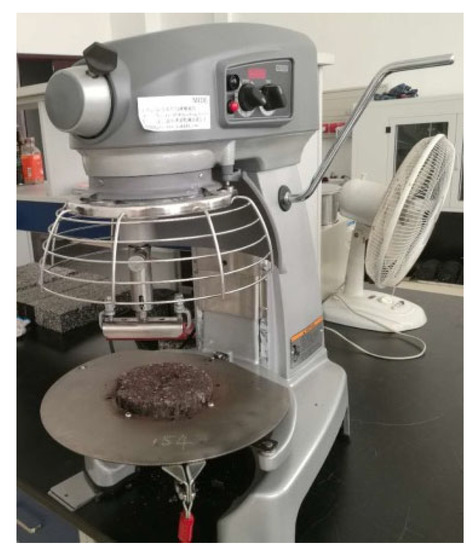
Figure 1.
Abrasion test instrument.
The test process was as follows. The mixture sample was formed with a height of 66 ± 2 mm. Then, the sample was placed into a temperature and humidity box. After curing, the mass of the test piece was weighed and it was put into a tray and fixed. The test environment was an indoor laboratory, and the temperature was 23 °C ± 3 °C. The test stopped after the wear head rotated for 15 min. The mass of the test piece was weighed and the wear loss was calculated using Formula (1). The effective number of samples could not be less than 3. The average value was taken as the abrasion loss in order to evaluate the initial abrasion resistance of the emulsified asphalt cold recycled mixture.
W—Wear loss, %;
ma—Quality of test piece before wear, g;
mb—Quality of test piece after wear, g.
This paper analyzed the influence of the gyratory compactor method and the large-scale Marshall compaction method on the abrasion loss of the emulsified asphalt cold recycled mixture. We designed a comparative test to determine the curing conditions of the abrasion test. Finally, the influence of different emulsifier types, emulsifier dosages, emulsified asphalt dosages, cement dosages, and mineral aggregate gradation on the wear loss was studied to determine the technical requirements for wear loss.
According to previous research results, coarse grading is commonly used in the cold recycling of emulsified asphalt. The study selected the coarse gradation A and the emulsified asphalt prepared using WS. The mixture was designed according to the “Technical Specification for Highway Asphalt Pavement Recycling” (JTG F41). It was determined that the cement dosage was 1.5%, the emulsified asphalt dosage was 3.5%, the cement strength grade was 42.5, and the optimal moisture content was 4.1%. The Marshall compaction times were 75 times on both sides. The times of the gyratory compactions were controlled by the height of the specimen. Preliminary tests showed that 30 times for the rotary compaction was more reasonable. The curing temperature was 25 °C and the relative humidity was 70%, and the abrasion loss after a curing time of 4h is shown in Figure 2.

Figure 2.
Test results of different modeling methods.
The specimens formed by the Marshall compaction method or gyratory compactor were demolded immediately and taken out completely. Table 3 shows that there was no significant difference between the two methods. ASTM D7196-06 recommends the use of rotary compactor to form the specimens. As Marshall devices are widely used worldwide, the results can be easily compared and spread. Hence, the large-scale Marshall compaction (75 times on both sides) was selected as the specimen molding method for wear testing in this study.

Table 3.
Relative humidity of some regions in China.
2.3. Curing Condition
The curing conditions are very important for the initial strength of the emulsified asphalt cold recycled mixture [19]. However, ASTM D7196-06 does not have regulations, which limits its application. This article analyzed the influence of key factors such as the curing temperature, humidity, and curing time on the anti-wear performance of the mixture to determine the appropriate curing conditions. The specimens were formed using the large-scale Marshall compaction method, the gradation type was A, the cement dosage was 1.5%, the emulsified asphalt was prepared by the emulsifier WS, the emulsified asphalt dosage was 3.5%, the cement strength grade was 42.5, and the optimal moisture content was 4.1%.
2.3.1. Curing Temperature
We used a temperature and humidity control box in the curing process. The relative humidity of preservation was set to 70%, and the time was 4h. The abrasion loss under different curing temperature conditions is shown in Figure 3.
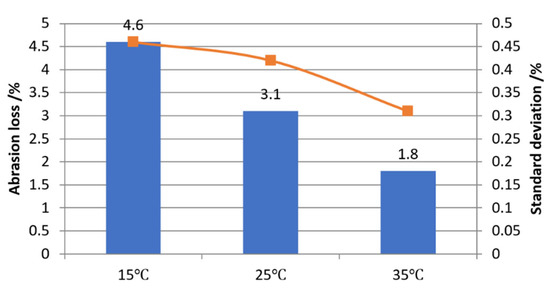
Figure 3.
Test results of different curing temperatures.
It can be seen from Table 4 that the temperature had a greater impact on the abrasion loss of the emulsified asphalt cold recycled mixture. With the increase in temperature, the abrasion loss decreased, which indicates that increasing the temperature could enhance the initial strength of the mixture. The abrasion test was carried out at room temperature, which was thus unable for simulating the initial strength formation process. The recommended temperature of ASTM D7196-06 in the United States is 18~24 °C. Considering that most of the test temperature in China is 25 °C, the proposed abrasion test curing temperature was 25 °C.

Table 4.
Variance analysis results of the abrasion loss of the emulsified asphalt cold recycled mixture.
2.3.2. Curing Relative Humidity
The relative humidity of curing is directly related to the cement hydration reaction. The abrasion loss of the cold recycled mixture under different relative humidity conditions is shown in Figure 4. The curing temperature was 25 °C and the curing time was 4 h.
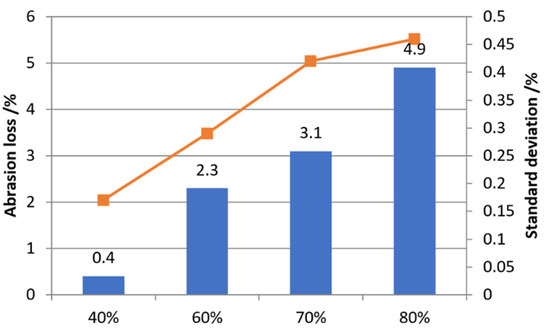
Figure 4.
Test results of different curing relative humidities.
It can be seen from Figure 4 that as the relative humidity increased, the abrasion loss of the emulsified asphalt cold recycled mixture gradually increased. The high humidity environment weakened the evaporation of water and affected the formation of the strength of the mixture. When the relative humidity was 40%, the abrasion loss was only 0.4%. A small value could not effectively distinguish the anti-wear performance of different types of emulsified asphalt cold recycled mixtures. At the same time, a low relative humidity affected the progress of the cement hydration reaction. The relative humidity in China from north to south is shown in Table 3.
It can be seen from Table 3 that in the past three years, the annual average humidity of these four provinces and cities was 65.5%. The average relative humidity from June to September was 71.4%. Combined with the relative humidity in other regions and the construction period of the cold recycled roads, 70% relative humidity covered the major provinces and cities in China. Therefore, the relative humidity of the proposed abrasion test was 70%.
2.3.3. Curing Time
The abrasion loss under the condition of a curing temperature of 25 °C and curing relative humidity of 70% is shown in Figure 5.
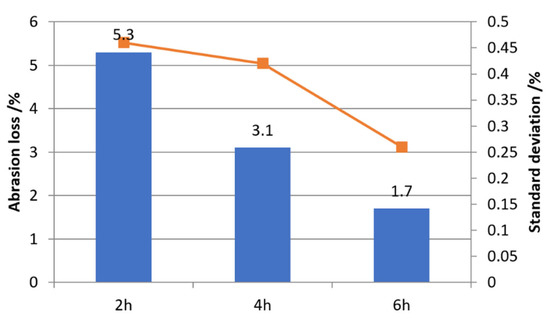
Figure 5.
Test results of different curing times.
The curing time has a great influence on the abrasion loss of the emulsified asphalt cold recycled mixture. With the extension of the curing time, the abrasion loss of the mixture gradually decreased, which indicates that its strength gradually formed. Combined with the recommended curing time of ASTM D7196-06, this paper used a curing time for the abrasion test of 4 h.
2.4. Wear Loss Technical Requirements
The test conditions of the abrasion test were as follows: large-scale Marshall compaction (75 times for each sides), temperature of 25 °C, relative humidity of 70%, and time of 4 h. This article analyzed several key factors such as the emulsifier type, emulsifier dosage, emulsified asphalt dosage, mineral material gradation, and cement dosage, and formulated the technical requirements for cold recycled mixture abrasion loss.
2.4.1. Emulsifier
Figure 6 shows the abrasion loss of the emulsified asphalt cold recycled mixture under different emulsifier types. The gradation type was A, the emulsified asphalt dosage was 3.5%, the cement dosage was 1.5%, the cement strength grade was 42.5, and the optimal moisture content was 4.1%.
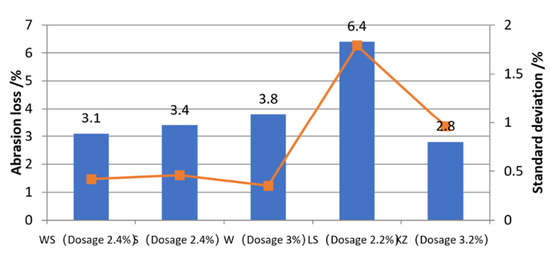
Figure 6.
Test results of different emulsifier types.
Different emulsifiers have an impact on the abrasion loss of the emulsified asphalt cold recycled mixture. The abrasion loss of the LS emulsifier was obviously greater than that of the other emulsifiers. The average abrasion loss of the remaining four emulsifiers was 3.3%.
2.4.2. Emulsifier Dosage
The dosage of the emulsifier is directly related to the performance of the emulsified asphalt [18]. The influence of different emulsifier dosages on the abrasion loss is shown in Figure 7. The gradation type was A, the emulsifier was WS, the amount of emulsified asphalt was 3.5%, the cement dosage was 1.5%, the cement strength grade was 42.5, and the moisture content was 4.1%.
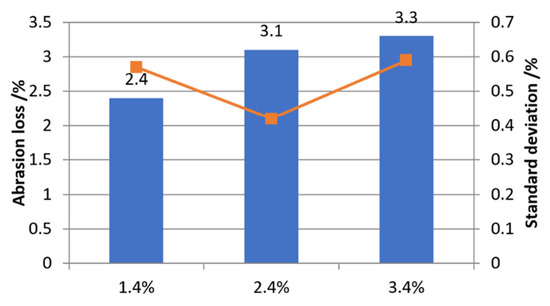
Figure 7.
Test results of different emulsifier dosages.
The emulsifier dosages had an impact on the abrasion loss of the emulsified asphalt cold recycled mixture, but the difference was not significant. The average abrasion loss under the three emulsifier dosage conditions was 2.9%.
2.4.3. Emulsified Asphalt Dosage
Figure 8 shows the abrasion loss of the cold recycled mixture of emulsified asphalt under different emulsified asphalt dosage conditions. The emulsifier was WS, the emulsifier dosage was 2.4%, the gradation type was A, the cement dosage was 1.5%, the cement strength grade was 42.5, and the optimal moisture content was 4.1%.
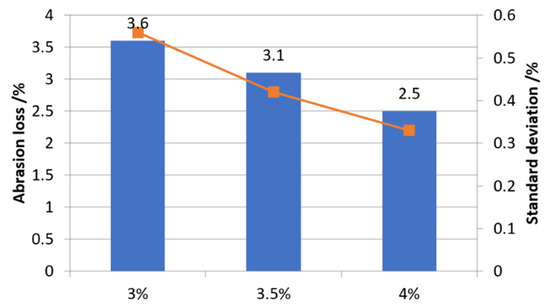
Figure 8.
Test results of different emulsified asphalt dosages.
An increased amount of emulsified asphalt can improve its abrasion resistance. The average abrasion loss of the cold recycled mixture of emulsified asphalt under the conditions of the three emulsified asphalt dosages was 3.1%.
2.4.4. Cement Dosage
Figure 9 shows the abrasion loss of the emulsified asphalt cold recycled mixture under different cement dosage conditions. The emulsifier was WS, the emulsifier dosage was 2.4%, the gradation type was A, the emulsified asphalt dosage was 3.5%, the cement strength grade was 42.5, and the optimal moisture content was 4.1%.
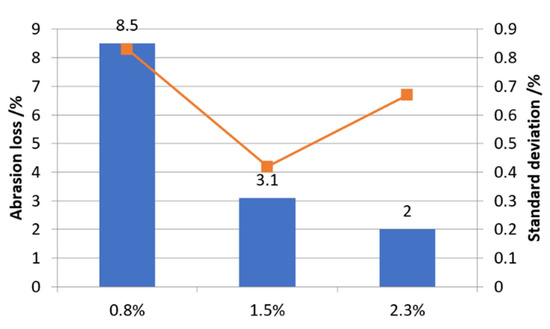
Figure 9.
Test results of different cement dosages.
The cement dosage had a greater impact on the abrasion loss of the emulsified asphalt cold recycled mixture. If the cement dosage was too low, the initial strength of the cold recycled mixture decreased significantly.
2.4.5. Cement Strength
The abrasion loss of the emulsified asphalt cold recycled mixture under different cement strength grade conditions is shown in Figure 10. The emulsifier was WS, the emulsifier dosage was 2.4%, the gradation type was A, the emulsified asphalt dosage was 3.5%, the cement dosage was 1.5, the cement strength grade was 42.5, and the optimal moisture content was 4.1%.

Figure 10.
Test results of the different cement strength grades.
Increasing the cement strength grade could reduce the abrasion loss of the emulsified asphalt cold recycled mixture, thereby improving the initial strength of the emulsified asphalt cold recycled mixture. Therefore, for the emulsified asphalt cold recycled pavement with a fast open-traffic demand, increasing the cement strength grade could improve the early strength of the cold recycled mixture.
2.4.6. Water Content
The water content will significantly affect the construction and workability of the emulsified asphalt cold recycled mixture. The abrasion loss of the emulsified asphalt cold recycled mixture under different moisture content conditions is shown in Figure 11. The emulsifier was WS, the emulsifier dosage was 2.4%, the gradation type was A, the emulsified asphalt dosage was 3.5%, the cement dosage was 1.5, and the cement strength grade was 42.5.
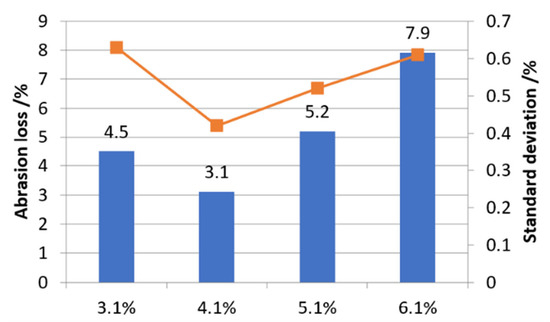
Figure 11.
Test results of different moisture contents.
Under optimal conditions, the water content was 4.1%. When compacted, the emulsified asphalt cold recycled mixture could effectively improve the density of the mixture, thereby reducing the initial wear loss of the cold recycled mixture. The moisture content of the cold recycled mixture was less than the optimal moisture content or greater than the optimal moisture content, which was not conducive to the improvement of the initial strength of the cold recycled mixture. Therefore, the compaction of the emulsified asphalt cold recycled mixture needs to be carried out under the optimal water content condition.
2.4.7. Mineral Grading
Figure 12 shows the abrasion loss of the emulsified asphalt cold recycled mixture under different gradation conditions. The emulsifier was WS, the emulsifier dosage was 2.4%, the emulsified asphalt dosage was 3.5%, the cement strength grade was 42.5, and the cement dosage was 1.5%.
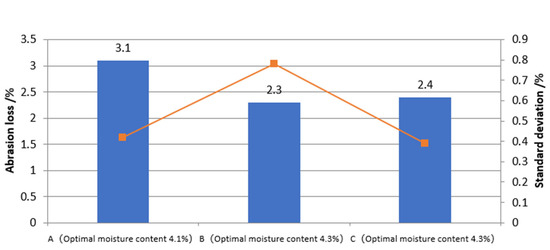
Figure 12.
Test results of different aggregate gradation types.
There were differences in the abrasion loss of the emulsified asphalt cold recycled mixture under different gradation conditions. When the gradation was coarser, the abrasion loss of the mixture was larger, and the average abrasion loss of the three gradations was 2.6%.
In practical engineering applications in China, the cement dosage of cold recycled asphalt emulsified mixture is generally not more than 1.5%. The amount of emulsified asphalt is generally not less than 3.0%. For both indexes, being too high or too low would have a negative impact on the performance of the mixture. Section 2.4.4 shows that when the cement dosage was 1.5%, the abrasion loss was 3.1%. Section 2.4.3 shows that when the amount of emulsified asphalt was 3.0%, the abrasion loss was 3.6%. Combining the results in Section 2.4.1, except for the LS emulsifier, the average abrasion loss of the remaining four emulsifiers was 3.3%. In addition to the test results of the mineral material grading and emulsifier dosage, combined with domestic and foreign data research, this paper proposes that the abrasion loss of the emulsified asphalt cold recycled mixture should not exceed 3.5%. The determination of 3.5% was mainly found through comprehensive research on different cement dosages, emulsified asphalt dosages, and other factors. For the emulsified asphalt cold recycled mixture in China, the cement dosage is generally not more than 1.5%, and the emulsified asphalt dosage is generally not more than 3.0%. In combination with the wear loss of these two indicators, other test conditions, and the domestic and foreign data research, the comprehensive determination was made.
In conclusion, the abrasion test can be used to evaluate the initial strength of the cold recycled mixture.
3. Data Variance Analysis
The variance analysis results of the emulsifier type, emulsifier dosage, emulsified asphalt dosage, cement dosage, mineral aggregate gradation, cement strength grade, and mixture moisture content on the cold recycled mixture abrasion loss are listed in Table 4. Among them, SS is the sum of squared deviations, DOF is the degree of freedom, MS is the mean square deviation, f is the statistic of the f distribution, p is the probability corresponding to the f value, and the significance level is 0.05. When p < 0.05, it indicates that this factor has a significant impact on the test results.
By comparing SS, it can be seen that the influencing factors of the abrasion loss of the cold recycled emulsified asphalt mixture are cement dosage > cement strength grade > emulsifier type > mineral aggregate gradation > emulsified asphalt dosage > water content of the mixture > emulsifier dosage. Cement has a great influence on the initial strength of the cold recycled asphalt emulsion mixture. The main reason is that after the emulsified asphalt cold recycled mixture is mixed with cement, the cement particles are covered by the emulsified asphalt in a short time, which delays the hydration reaction of the cement to a certain extent. This affects the formation of strength, but the cement will accelerate the emulsified asphalt. Demulsification causes the initial strength to increase rapidly, and at the same time, the demulsification asphalt and hydrate will form a reinforced structure, which further increases the initial strength.
It can be seen from the p value that the cement dosage, cement strength grade, emulsifier type, and mineral aggregate grade have a significant influence on abrasion loss. Therefore, the initial strength of the emulsified asphalt cold recycled mixture design should focus on the four influencing factors of cement dosage, cement strength grade, emulsifier type, and mineral aggregate gradation.
4. Conclusions
- (1)
- In this study, a method for evaluating the initial wear resistance of the emulsified asphalt cold recycled mixture was proposed. The key parameters of the abrasion test were clarified by the test. The test results of this method are simple and reliable.
- (2)
- This study put forward the evaluation indexes and technical requirements for the initial anti-wear performance of an emulsified asphalt cold recycled mixture. Taking an abrasion loss of not more than 3.5% as the control index can be used as the basis for optimizing the design of the mixture ratio.
- (3)
- The influencing factors of the initial abrasion loss of the cold recycled emulsified asphalt mixture are in the order of cement dosage > cement strength grade > emulsifier type > mineral aggregate gradation > emulsified asphalt dosage> mixture moisture content > emulsifier dosage. The cement dosage, the type of emulsifier, and the grade of mineral aggregate have a significant effect on the initial strength of the mixture.
- (4)
- This study proposed the key parameters for the abrasion test of a cold recycled asphalt emulsified mixture. Through the analysis of variance method, the key influencing factors that affect the initial strength of the cold reclaimed mixture of emulsified asphalt are determined.
- (5)
- Based on China’s conditions, the abrasion test specimens are formed using the large-scale Marshall method. The curing temperature was 25 °C, the curing relative humidity was 70%, and the curing time was 4h, following the standard test conditions for the abrasion test of China’s emulsified asphalt cold recycled mixtures.
- (6)
- In the future, it is recommended that the emulsified asphalt cold recycled mixture should be further studied under different climate and disease conditions.
Author Contributions
Conceptualization, W.D.; methodology, T.L.; validation, Q.L.; formal analysis, J.X.; data curation, J.Z.; writing—original draft preparation, J.W.; writing—review and editing, R.C.; supervision, Y.Q. All authors have read and agreed to the published version of the manuscript.
Funding
This research was funded by [the basic scientific research of central institute: 2021-9045a].
Institutional Review Board Statement
Not applicable for studies not involving humans or animals.
Informed Consent Statement
Not applicable.
Data Availability Statement
Not applicable.
Conflicts of Interest
The authors declare no conflict of interest.
References
- Xu, J.; Huang, S.; Zou, G. Recycling Technology of Asphalt Pavement for Highway; China Communication Press: Beijing, China, 2011. [Google Scholar]
- Kim, Y.; Lee, H.; Heitzman, M. Dynamic Modulus and Repeated Load Tests of Cold In-place Recycling Mixtures Using Foamed Asphalt. J. Mater. Civ. Eng. 2009, 21, 279–285. [Google Scholar] [CrossRef]
- Moghadam, B.B.; Mollashahi, H.F. Suggesting A Simple Design Method for Cold Recycled Asphalt Mixes with Asphalt Emulsion. J. Civ. Eng. Manag. 2017, 23, 966–976. [Google Scholar] [CrossRef]
- Xu, J.; Huang, S.; Qin, Y. Performance of Cold Recycled Mixtures with Emulsified Asphalt or Foam Asphalt. J. Highw. Transp. Res. Dev. 2010, 27, 20–24. [Google Scholar]
- Arimilli, S.; Jain, P.K.; Nagabhushana, M.N. Optimization of Recycled Asphalt Pavement in Cold Emulsified Mixtures by Mechanistic Characterization. J. Mater. Civ. Eng. 2016, 28, 04015132. [Google Scholar] [CrossRef]
- Kim, Y.; Im, S.; Lee, H.D. Impacts of Curing Time and Moisture Content on Engineering Properties of Cold In-place Recycling Mixtures Using Foamed or Emulsified Asphalt. J. Mater. Civ. Eng. 2011, 23, 542–553. [Google Scholar] [CrossRef]
- Zhang, D.; Fang, L.; Wang, J. Characteristics of strength and Fatigue Damage for Emulsified Asphalt Cold Recycled Mixture. Highw. Eng. 2016, 41, 236–241. [Google Scholar]
- Wu, C.; Zeng, M.; Zhong, M.; Xiao, J. Experimental Study of the Design Method for Cold Recycled Mixture Using Asphalt Emulsion. J. Hunan Univ. Nat. Sci. 2008, 35, 19–23. [Google Scholar]
- Wei, T.; Hong, J.; Lin, J. Effect and Action Mechanism of Cement and Emulsified Asphalt on the Strength of Cold Regeneration. J. Build. Mater. 2017, 20, 310–315. [Google Scholar]
- Wang, Z.; Hao, P.; Liu, H. Study on Fatigue Performance of Emulsified Asphalt Cold Recycles Mixture. J. Highw. Transp. Res. Dev. 2015, 32, 28–32. [Google Scholar]
- Ma, T.; Wang, H.; Zhao, Y. Laboratory Investigation on Residual Strength of Reclaimed Asphalt Mixture for Cold Mix Recycling. Int. J. Pavement Res. Technol. 2015, 8, 17–22. [Google Scholar]
- Zhao, Y.; Ni, F.; Zhou, L.; Gao, L. Three-dimensional Fracture Simulation of Cold In-place Recycling Mixture Using Cohesive Zone Model. Constr. Build. Mater. 2016, 120, 19–28. [Google Scholar] [CrossRef]
- Research Institute of Highway of Ministry of Transport. Technical Specifications for Highway Asphalt Pavement Recycling; China Communication Press: Beijing, China, 2008. [Google Scholar]
- Geng, J.; Chen, Z.; Li, L.; Jingliang, D. Mixing Design of Cement-emulsified-asphalt-cold-recycle mixture. J. Chang. Univ. Nat. Sci. Ed. 2009, 29, 10–14. [Google Scholar]
- Lin, J.; Wei, T.; Hong, J.; Zhao, Y.; Liu, J. Research on Development Mechanism of Early-stage Strength for Cold Recycled Asphalt Mixture Using Emulsion Asphalt. Constr. Build. Mater. 2015, 99, 137–142. [Google Scholar] [CrossRef]
- Wang, H.; Liu, F.; Yu, J. Research on Curing Methods of Emulsified Asphalt Cold Recycled Mixture. J. Wuhan Univ. Technol. Transp. Sci. Eng. 2015, 641–646. [Google Scholar]
- Gao, L.; Ni, F.; Luo, H.; Yang, M. Permeability and Air Voids of Cold Recycled Mixtures with Asphalt Emulsion. J. Southeast Univ. Nat. Sci. Ed. 2015, 45, 581–585. [Google Scholar]
- Xing, C.; Jiang, W.; Li, M.; Wang, M.; Xiao, J.; Xu, Z. Application of atomic force microscopy in bitumen materials at the nanoscale: A review. Constr. Build. Mater. 2022, 342, 128059. [Google Scholar] [CrossRef]
- Graziani, A.; Godenzoni, C.; Cardone, F.; Bocci, M. Effect of curing on the physical and mechanical properties of cold-recycled bituminous mixtures. Mater. Des. 2016, 95, 358–369. [Google Scholar] [CrossRef]
Publisher’s Note: MDPI stays neutral with regard to jurisdictional claims in published maps and institutional affiliations. |
© 2022 by the authors. Licensee MDPI, Basel, Switzerland. This article is an open access article distributed under the terms and conditions of the Creative Commons Attribution (CC BY) license (https://creativecommons.org/licenses/by/4.0/).